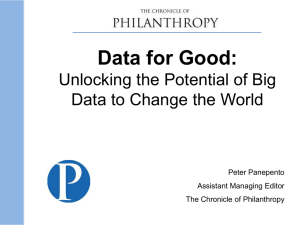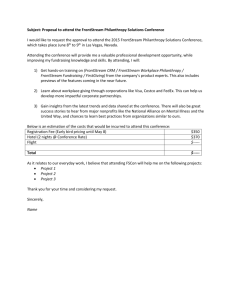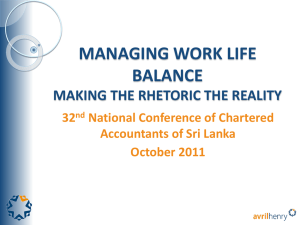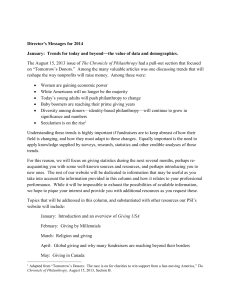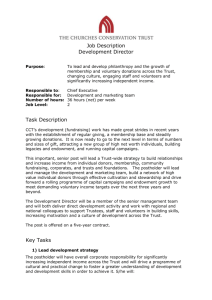Word - Arts Council England
advertisement
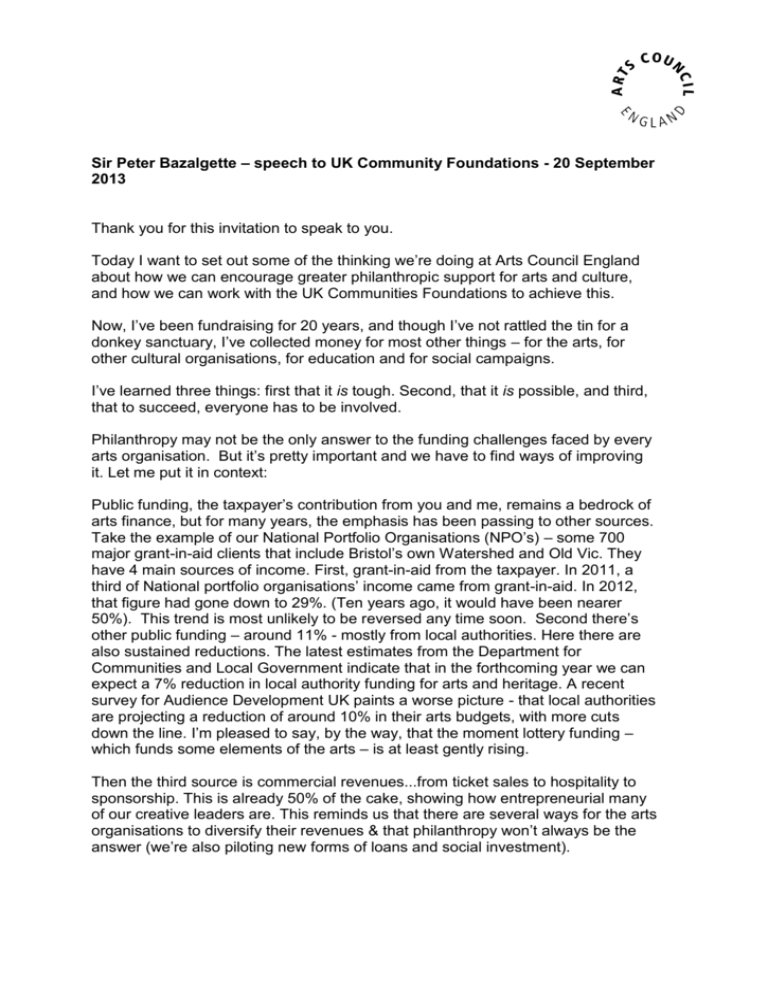
Sir Peter Bazalgette – speech to UK Community Foundations - 20 September 2013 Thank you for this invitation to speak to you. Today I want to set out some of the thinking we’re doing at Arts Council England about how we can encourage greater philanthropic support for arts and culture, and how we can work with the UK Communities Foundations to achieve this. Now, I’ve been fundraising for 20 years, and though I’ve not rattled the tin for a donkey sanctuary, I’ve collected money for most other things – for the arts, for other cultural organisations, for education and for social campaigns. I’ve learned three things: first that it is tough. Second, that it is possible, and third, that to succeed, everyone has to be involved. Philanthropy may not be the only answer to the funding challenges faced by every arts organisation. But it’s pretty important and we have to find ways of improving it. Let me put it in context: Public funding, the taxpayer’s contribution from you and me, remains a bedrock of arts finance, but for many years, the emphasis has been passing to other sources. Take the example of our National Portfolio Organisations (NPO’s) – some 700 major grant-in-aid clients that include Bristol’s own Watershed and Old Vic. They have 4 main sources of income. First, grant-in-aid from the taxpayer. In 2011, a third of National portfolio organisations’ income came from grant-in-aid. In 2012, that figure had gone down to 29%. (Ten years ago, it would have been nearer 50%). This trend is most unlikely to be reversed any time soon. Second there’s other public funding – around 11% - mostly from local authorities. Here there are also sustained reductions. The latest estimates from the Department for Communities and Local Government indicate that in the forthcoming year we can expect a 7% reduction in local authority funding for arts and heritage. A recent survey for Audience Development UK paints a worse picture - that local authorities are projecting a reduction of around 10% in their arts budgets, with more cuts down the line. I’m pleased to say, by the way, that the moment lottery funding – which funds some elements of the arts – is at least gently rising. Then the third source is commercial revenues...from ticket sales to hospitality to sponsorship. This is already 50% of the cake, showing how entrepreneurial many of our creative leaders are. This reminds us that there are several ways for the arts organisations to diversify their revenues & that philanthropy won’t always be the answer (we’re also piloting new forms of loans and social investment). D:\116097874.doc But philanthropy is nevertheless the 4th very important leg supporting arts and culture, currently delivering 11% of our NPOs income. Our Secretary of State for Culture, Maria Miller, has summarised it nicely: “The Government is committed to a mixed economy model where targeted public funding will stimulate money from other sources, whether that is philanthropy or commercially generated.” So, how are we going to improve our fundraising ? First, today I’d like to consider a misconception that exists about the relationship between the arts and the charitable sector – a misconception that we need to overcome. It’s a question of identity. One of the reasons it can be tough to raise funds for the arts is that in the wider public mind, the arts are not necessarily a charitable cause. A recent YouGov poll that asked people what types of organisations they thought public funding for the arts was spent on, revealed that only 9% thought money went to charities – though nearly all the Arts Council’s funding goes to organisations with charitable status. We’re not connecting with potential donors; we’re not getting the message over. We are a charitable nation – according to the Charities Aid Foundation, only the United States tops us: in 2006 we were giving nearly three-quarters of one percent of GDP to charity. But the arts get a tiny share. Again, according to the Charities Aid Foundation, just 1% of the pot goes to organisations that promote the arts. Surely we can do better than that? But, here’s another interesting figure, taken from the 2012 Coutts Survey, which shows that among those who gave a million pounds or more to charitable causes, the arts did substantially better. In fact, the arts were third in the list of causes, behind foundations and higher education, receiving gifts totalling £109 million or nearly 9% of the pot. And in their book, Richer Lives: Why Rich People Give, (being published this month) Beth Breeze and Theresa Lloyd show that among their research sample of rich givers, arts and culture were the most popular cause, with an average individual gift size of £225,000. What this tells us is that while we can attract the upper end of donors, we have been less successful with the smaller donors, and although they may not be so rich, there are very many more of them - and they give generously to many other charitable causes. This is a major marketing challenge to all of us in the arts. The public isn’t aware of how deeply embedded the arts are in their daily lives, and how vital the arts are to every aspect of communities across the nation. Just look at some of the causes that The Charities Aid Foundation reveals are most popular with average donors. Education? Well, we do that. To take one example among many - one that I know well, having seen and loved their work - the Arts Council supports the remarkable Graeae Theatre Company, whose wonderful production of Ted Hughes’s Iron Man is used as a basis for primary schools workshops in communicating and problem solving – as well as challenging preconceptions about disability. What about the homeless? We’re involved there too. Take Streetwise Opera, who each year help some 500 homeless people regain their self respect, running a weekly music programme in homeless centres across England and Wales. What about older people? We do that. This April we launched a million pound arts and older people in care programme, funded jointly with the Baring Foundation, that will bring quality arts to older people in residential homes. What about public well-being? Yes, we do that too. Take our pioneering Books on Prescription scheme, in which Arts Council England invested £19,000, working with the Reading Agency and the Society of Chief Librarians. This made available self-help books for people suffering from mental health problems. It is, in the words of one health worker, “a fantastic service.” That’s just one example of many. As Alan Yates, chief executive of Mersey Care NHS Trust puts it: “if the arts had not been invented, we would now do so, as a front line NHS service.” The truth is that the arts work everywhere in our communities; helping the retired, the marginalised, the lonely and the sick. We arrange dance classes, organise choirs and hand out books. The arts are a critical factor in social engagement. Just look at the numbers who participate voluntarily in arts and cultural organisations some 9.4 million people. There’s a message we need to figure out how to get over much more effectively. And that’s something I hope the UK Community Foundations will help us with, via the great work you do with the arts. In Herefordshire the community foundation is supporting a wide range of arts projects including the annual Herefordshire Young Musician of the year Award; in Northamptonshire, the community foundation manages a bursary scheme for the youth theatre at the Royal and Derngate; in Milton Keynes, the foundation has helped fund an arts training programme; and in Norfolk the Community Foundation has a record of supporting charities who reach disadvantaged and disabled children through the arts. The best estimate is that some 30% of community foundations projects use the arts as a tool in their work. But I’m not sure that’s widely appreciated. Let’s get it known. In his report, Philanthropy Beyond London, commissioned by the DCMS last year, one of Peter Phillips’ key recommendations was that arts organisations should ‘stress their charitable status with conviction’. He’s right. We must get across the holistic nature of our work. Now, as all of us here today know...when you’re fundraising you look to 3 sources: Trusts and Foundations, Businesses and Individuals. A brief word about trusts and foundations. There’s evidence of good progress here by the arts sector, fuelled by our Catalyst Matching Scheme, which I’ll say more about later. Catalyst has enabled more than 400 arts organisations to go out and pitch to trusts in a more focussed and powerful way. It’s early days but there’s no doubt the matching principle appeals to trusts. Six years ago, after the credit crunch, corporate giving fell off a cliff. Companies are now doing considerably better- they’ve got rid of their debts and repaired their balance sheets. In fact the latest figures show that since 2008, FTSE-100 companies – excluding banks – have added more than £40 billion to their cashpile. Your average FTSE firm now has £1.9 billion in the bank. It’s good to see them healthy again - and it’s a shame that many have not restored the support they gave to the arts before the recession. My message to them is...come and join us again, and it’s in your interests to have a lively, attractive local culture. I was at Kenneth Branagh’s blood-and-guts Macbeth this summer, part of the Manchester International Festival made possible with £2 million from 5 local businesses. This brought 30,000 visitors from the UK and abroad to Manchester and was worth £5.1 million to the local economy. More recently Exeter’s Unexpected Festival, was sponsored by two retail centres, a train company, a bus company, a hotel chain and a housing association. Up in Hull, the Freedom Festival is being supported by a communications company as part of their longstanding investment in local culture and businesses, as well as by the port owners, developers and an aquarium. And take the example of Bruntwood, who provide office facilities throughout the north, and have established the £80,000 Bruntwood prize for playwriting, as well as supporting the Royal Exchange Theatre and the West Yorkshire Playhouse. What do they say about their reasons for giving? They say: “Cities need more than just successful businesses; they need culture and life to thrive.” If you want the best employees to want to live in your area, if you want great graduates from your local universities, it’s all about the local quality of life. And these far-sighted companies across England do underline that although it may be more difficult to fundraise outside the charmed circle of the major arts organisations in London, it is, as I said earlier, genuinely possible. The sculptor Anthony Gormley, creator of the Angel of The North, talked recently about the different attitude towards giving in Japan – where, he says “there is an absolute belief in the duty of corporate money to reinvest in a collective future.” Businesses could do more; maybe they want to and would – we just haven’t asked them. A new report from the United States – where corporate giving is much more established – asked businesses why they did not give to the arts: the answer 66% of them gave was that they had not been approached. So we in the arts have to learn how to ask, matching our appeal to companies’ stated priorities, something else the UK Communities Foundation can teach us. And the third critical constituency of donors is, of course, individuals. It’s individuals who’ve, in many cases, been magnificent in increasing their support during this tricky period. And once again there are people here who are showing us the way: last year the Community Foundation Tyne and Wear gave nearly a quarter of the money it granted to projects involving arts and culture. They’ve pioneered the Vital Signs report as a means to identify community needs and have successfully used the Theory of Change method to help donors see where they can contribute to the community by giving to the arts. Clever, analytical, tactical and perfectly communicated. One of the key incentives to encourage private donations are the tax breaks which exist to sweeten the pill. But I believe we have much work to do to extract maximum advantage from them. Sometimes they’re not properly understood...partly because the Treasury kindly allows us the tax breaks but it’s not in their nature to market them. But we can. I remember speaking to 100 potential legacy givers at English National Opera, where I was Chair. Only 2 knew that if you leave 10% of your estate to charity you can reduce your inheritance tax. And our research at the Arts Council tells us that even when both donors and recipients know about some breaks, such as share gifts, they find them complicated and involved. We have to help with that, and we have to get the legal and accountancy professions to assist us more than they do. Back in 2011, the Philanthropy Review estimated that an additional £2billion of charitable income could be achieved if we could encourage giving by making it a social norm - and if we could make it easier for people to give, especially through the tax system. And let me give a warm welcome, at this point, to the new Cultural Gifts Scheme which began this March. It’s opened a door for donors to give objects during their lifetimes and claim substantial tax relief based on their value – our first contribution came from Hunter Davies, who donated some of John Lennon’s handwritten lyrics to Beatles’ songs. It’s early days but if the scheme takes off then future governments might be encouraged to look at further incentives to lifetime giving, as has been recommended by the Philanthropy Commission and by Theresa Lloyd and Beth Breeze. Before I leave the subject of individual giving, a couple of other important points. There’s one group in society to whom even the last 5 years have been kind. The so-called baby boomers. I know because I’m one of them (as is proved by my familiarity with Beatles’ hits). We’ve had 40 years of house price inflation, final salary pensions and uncapped pension contributions. And now, in our 60’s and 70’s we have time on our hands. A good number are supporting their local arts organisations but there are so many more who’d love it if they were too. Let’s recruit this hidden army...I know myself that when you get involved the rewards are far greater than the money or time you put in. And the other thing is that we need to harness the new digital world to make our fundraising far more effective than ever before. Data collection and sharing to reveal potential new supporters amongst existing arts attenders. New forms of giving, like the new prototype mobile giving platform, Donate, which is being piloted at locations including the National Portrait Gallery and the V&A, allowing people to give live, at the point they’re most gratified by the experience they’re having. And interactive exhibits connecting with smartphones, which are becoming widely used across many of the world’s leading museums. These create user relationships where previously you couldn’t know who was visiting. We are also investing substantially in other initiatives that will encourage information sharing, including £7.5 million on the Audience Focus Grant. As part of this, we are spending more than £3million over three years to help audience development agencies evolve a national database of arts attendees, and to provide our organisations with toolkits for audience analytics. At the Arts Council we definitely see it as our job to help our sector raise more money...we’re working on new strategies and we’re already driving several promising projects. Let me tell you about them. First, I mentioned Catalyst earlier, now two years old. So far, there have been 408 successful applicants to the three strands of the scheme - and Arts Council England is helping many of them create endowment-style funds powered by the dynamic matching principle. Here’s how it can work in practice: take the example of Booktrust, the reading charity. Booktrust wanted to reach disadvantaged children, whose limited access to books held them back in life. Preparing to fundraise to match their Catalyst grant they discovered the public didn’t understand they needed donations. Because Booktrust were already known to be in receipt of public money the public thought they didn’t need charitable donations. So Booktrust created a separate fund – the Children’s Reading Fund – that could be distanced from their main brand. And they also identified cultural changes within their organisation: to operate charitably, they had to become more commercially minded. (Charities have to be good businesses, of course.) They had to overcome their reticence and ask for money, appealing to celebrity supporters and their existing contacts for donations. The results of this reappraisal were marked: as of March this year, Booktrust had raised or pledged funds in excess of £400,000, which matching funding from our Catalyst programme took to £520,00. They cracked the marketing issue about being a charity and raised additional funds with the help of matching, all in one virtuous circle. Through the Catalyst Endowment Fund, matching private money raised, we’re now helping organisations towards a target of £106 million in donations. And Catalyst has stimulated some impressive individual donations. The Turner Contemporary Gallery in Margate has secured a single gift of £530,000 from Goldman Sachs. The Sage in Gateshead is launching a second endowment appeal and has been given £500,000 by Dame Margaret Barbour, and Circus Space has secured a pledge of $1 million from the philanthropist Aileen Getty. The Bowes Museum has already exceeded its targets for the year, with some £350,000 in pledges against a target of £300,000. Just as importantly, as part of Catalyst, we’re improving the fund-raising skills of our workforce. We are committing £30 million to help 173 organisations strengthen their fundraising capacity. And because we’ll need a new generation of skilled fundraisers to help manage this change, we’ve now launched a separate but connected initiative...the second innovation I wanted to tell you about. We’ve invested £2 million in a new fellowship in fundraising based at Leeds University and run by the Arts Fundraising and Philanthropy Consortium, bringing together numerous partners across the arts and charitable sectors. On the first day of recruitment, I was there to meet 65 bright, ambitious graduates competing for 11 places. This is the beginning of a new generation of trained fundraisers supporting the arts, joining the existing experts we already have in our larger organisations. I said at the beginning that it’s tough raising money, which I’ve acknowledged today. But I said it was possible – I’ve given you some inspiring examples today. And I also said everyone in an arts organisation is involved. We’re inclined to appoint the head of development and think the job is done. But it’s often the Boards and senior executives who land the biggest donations and we need more folk who know how to do this, strategically and determinedly. So, from October, the Arts Fundraising and Philanthropy Programme, backed by the Arts Council, is running a nine-month series of governance training sessions aimed at chief executives and trustees, led by outstanding individuals from the charitable sector and I’m delighted that we’re working with the UK Communities Foundations to get regional philanthropists to come along too. Personally I think every arts board member should contribute, whether it’s one pound or a million, according to their circumstances. We are all involved. And if you’re going to ask, you should first have given, whether it’s time or money. Something else: to further these ideas we’re planning a new annual event from 2014...working title: ‘Why give to Culture?’...where we intend to get the legal and accountancy professions together with charity advisers, investment advisors, business’s CSR leaders and the CEO’s of Community Foundations. And I’m very pleased to have Matthew Bowcock, your former Chair, joining the Arts Council this week to help us develop these strategies further (where he’ll be working with Peter Phillips whom I mentioned earlier). Oh, and one other thing, people who give generously like to be thanked, and indeed, richly deserve to be thanked. I’m promising to write to thank any significant donors to any of our partner arts organisations. It might be £100 or ten million pounds, but it has to have made a real difference. Because I do have a day job I’m restricting it to 2 donors per organisation per year. My first ones have just gone out...to supporters of Opera North in Leeds and the Hall for Cornwall theatre in Cornwall. In conclusion, while all arts organisations need to find additional sources of revenue, and philanthropy is not always the answer – it’s an incredibly important answer nevertheless. And one where we genuinely have the means to increase it if we pursue the right strategies. I strongly believe that we can improve fundraising for arts and culture, chiefly because we already have so many good examples of inspiring generosity. We know what’s possible. And it’s something we have to do our world class culture may be admired internationally but by us it’s cherished. It’s not just part of our national conversation but the very essence of who we are. It’s a wonderful thing to support. Thank you.
